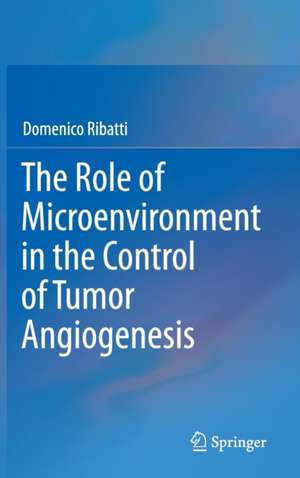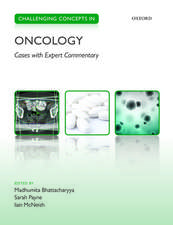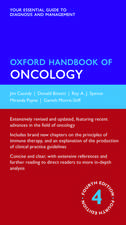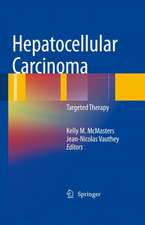The Role of Microenvironment in the Control of Tumor Angiogenesis
Autor Domenico Ribattien Limba Engleză Hardback – 16 feb 2016
Under physiological conditions, angiogenesis is dependent on the balance of positive and negative angiogenic modulators within the vascular microenvironment and requires the functional activities of a number of molecules, including angiogenic factors, extracellular matrix proteins, adhesion molecules and proteolytic enzymes.
In normal tissues, vascular quiescence is maintained by the dominant influence of endogenous angiogenesis inhibitors over angiogenic stimuli.
Tumor angiogenesis is linked to a switch in the balance between positive and negative regulators, and mainly depends on the release by inflammatory or neoplastic cells of specific growth factors for endothelial cells, that stimulate the growth of the blood vessels of the host or the down-regulation of natural angiogenesis inhibitors.
In particular, the inflammatory infiltrate may contribute to tumor angiogenesis, and there are many reports of associations between tumor inflammatory infiltrate, vascularity and prognosis.
New therapeutic approaches have been developed with the aim to control tumor angiogenesis through targeting of different components of tumor microenvironment.
| Toate formatele și edițiile | Preț | Express |
|---|---|---|
| Paperback (1) | 704.95 lei 43-57 zile | |
| Springer International Publishing – 30 mar 2018 | 704.95 lei 43-57 zile | |
| Hardback (1) | 711.88 lei 43-57 zile | |
| Springer International Publishing – 16 feb 2016 | 711.88 lei 43-57 zile |
Preț: 711.88 lei
Preț vechi: 749.34 lei
-5% Nou
Puncte Express: 1068
Preț estimativ în valută:
136.21€ • 142.60$ • 112.71£
136.21€ • 142.60$ • 112.71£
Carte tipărită la comandă
Livrare economică 07-21 aprilie
Preluare comenzi: 021 569.72.76
Specificații
ISBN-13: 9783319278186
ISBN-10: 3319278185
Pagini: 104
Ilustrații: XI, 86 p. 28 illus., 16 illus. in color.
Dimensiuni: 155 x 235 x 8 mm
Greutate: 0.32 kg
Ediția:1st ed. 2016
Editura: Springer International Publishing
Colecția Springer
Locul publicării:Cham, Switzerland
ISBN-10: 3319278185
Pagini: 104
Ilustrații: XI, 86 p. 28 illus., 16 illus. in color.
Dimensiuni: 155 x 235 x 8 mm
Greutate: 0.32 kg
Ediția:1st ed. 2016
Editura: Springer International Publishing
Colecția Springer
Locul publicării:Cham, Switzerland
Public țintă
ResearchCuprins
Prelims.- Tumor microenvironment.- Tumor blood vessels and tumor endothelial cells.- Tumor angiogenesis.- Inflammatory cells in tumor microenvironment.- Therapeutic strategies, the concept of “normalization” and the role of VEGF inhibition.- Index.
Textul de pe ultima copertă
This work describes the importance of tumor microenvironment in favouring tumor progression and angiogenesis.
Under physiological conditions, angiogenesis is dependent on the balance of positive and negative angiogenic modulators within the vascular microenvironment and requires the functional activities of a number of molecules, including angiogenic factors, extracellular matrix proteins, adhesion molecules and proteolytic enzymes.
In normal tissues, vascular quiescence is maintained by the dominant influence of endogenous angiogenesis inhibitors over angiogenic stimuli.
Tumor angiogenesis is linked to a switch in the balance between positive and negative regulators, and mainly depends on the release by inflammatory or neoplastic cells of specific growth factors for endothelial cells, that stimulate the growth of the blood vessels of the host or the down-regulation of natural angiogenesis inhibitors.
In particular, the inflammatory infiltrate may contributeto tumor angiogenesis, and there are many reports of associations between tumor inflammatory infiltrate, vascularity and prognosis.
New therapeutic approaches have been developed with the aim to control tumor angiogenesis through targeting of different components of tumor microenvironment.
Under physiological conditions, angiogenesis is dependent on the balance of positive and negative angiogenic modulators within the vascular microenvironment and requires the functional activities of a number of molecules, including angiogenic factors, extracellular matrix proteins, adhesion molecules and proteolytic enzymes.
In normal tissues, vascular quiescence is maintained by the dominant influence of endogenous angiogenesis inhibitors over angiogenic stimuli.
Tumor angiogenesis is linked to a switch in the balance between positive and negative regulators, and mainly depends on the release by inflammatory or neoplastic cells of specific growth factors for endothelial cells, that stimulate the growth of the blood vessels of the host or the down-regulation of natural angiogenesis inhibitors.
In particular, the inflammatory infiltrate may contributeto tumor angiogenesis, and there are many reports of associations between tumor inflammatory infiltrate, vascularity and prognosis.
New therapeutic approaches have been developed with the aim to control tumor angiogenesis through targeting of different components of tumor microenvironment.
Caracteristici
Tumor microenvironment is involved in the control of tumor growth and progression Inflammatory cells play a crucial role in the control of tumor microenvironment characteristics A new therapeutic approach in thetreatment of cancer is the modulation of the biological activity of thesecellular components














